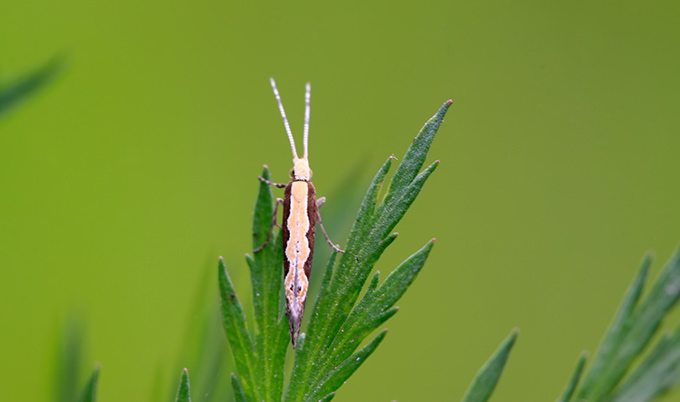Channel-hopping moth plague
Comment: Our clothes are safe, but mind the cabbages
Published on: 17 June 2016
Writing for The Conversation, Callum Macgregor talks about the threat of the Channel-hopping Diamondback moths.

The next great plague has descended, and this time it’s moths. Diamondback moths have been crossing the English Channel over the past fortnight in far greater numbers than usual.
Those of you reaching for moth-balls and carpet sprays, stop. There are only two species of British moth (from a cast of thousands) that damage clothes, and the diamondback is not one of them. You, the reader, really don’t need to worry – unless you grow cruciferous vegetables like cabbages or broccoli.
Plutella xylostella – more commonly known as the diamondback – is one of the world’s most widespread and prevalent agricultural pests; so widespread, indeed, that scientists disagree as to where exactly its native range lies.
Their success belongs in part to their preference as caterpillars for eating plants in the Brassicaceae family. This amazing group of crops (notably the species Brassica oleracea) has been selectively bred over hundreds of years to make use of almost every part of the plant, and now contains many popular vegetables such as cabbages, broccoli, Brussels sprouts and turnips, as well as oil-seed rape. The moths lay eggs on brassica leaves; a week later, caterpillars hatch and start eating. An infested plant can quickly be reduced to little more than leaf stems.
Cross-Channel travellers
Despite being one of the smallest moth species to occur in the UK, with a wingspan of under 15mm, diamondbacks are capable of dispersing vast distances, using the wind to make up for their small size. Research has shown that without assistance, diamondbacks are only capable of flying 35 metres – yet when carried along by the wind, they may travel hundreds of miles in a single day.
It is this ability to disperse that leads it to British shores. Every summer, adults cross the Channel and attempt to breed in the UK. A number of butterfly and moth species employ this strategy. In some cases, such as the Painted Lady butterfly, the offspring will return south ahead of the winter. For others, including diamondbacks, the offspring will attempt to remain, but British winters are typically too cold for them to survive.

For the moths, these fatalities are an unfortunate side effect of a highly dispersive life history; by having offspring constantly travelling beyond the edge of their range and attempting to breed, the moths ensure that no available space is wasted. Should some of the dispersing moths find a new area that is suitable for breeding success, they will benefit enormously from a lack of competition with their peers and, potentially, the absence of specialised predators and parasites. Thus, evolution favours and preserves these intrepid explorers.
Supermoth?
And it is once the moths begin to breed that the problems begin for farmers and gardeners, because these are not your average pest. Diamondback has been referred to in some coverage as a “super-moth”. It’s a title it certainly deserves.
The species has proven itself to be extraordinarily adept at evolving resistance to pesticides. Wild populations have developed significant resistance to almost every significant synthetic insecticide in use, including one of the main classes, pyrethroids.
Perhaps more impressively, diamondback was the first insect recorded to have developed resistance in the field to the bacterial pesticide Bacillus thuringiensis; only one other species is known to have managed this since (the “cabbage looper”, a pest moth named after its favourite food). Interestingly, this has led scientists to target it with the same genetic tools as are employed against the mosquitoes that transmit dengue fever and Zika virus. Field trials are planned in the US for this summer.
Tough times on the veg patch
In the short-term, perhaps. The influx of moths will soon begin to produce larvae, and these may cause substantial damage to crops where they are able to escape death by insecticide. The damage will be most severe to farmers of leaf crops, such as cabbages or kale, as the holes left behind in leaves by caterpillars make the crop unsellable.

Looking at the longer term, this year’s invasion will die out over the winter. Next year there will be another, but this is nothing new: these moths come to the UK every year in substantial numbers. I spent the summer of 2014 collecting moths on farms in Oxfordshire for a study on the effects of light pollution on moths. Out of the 203 species of moth I recorded, diamondback was the 26th most common, forming around 1% of my total catch.
Britain’s cabbage-growers have been dealing with diamondback for years and have managed to persist thus far. They may have a hard summer ahead of them but it is not without hope. Although globally diamondbacks have developed resistance to almost all pesticides, most populations are only resistant to a subset of these, and scientists at Rothamsted Research are already studying the current influx to identify their weaknesses. Armed with the results of that research, farmers may be capable of restricting the damage.
Callum Macgregor, PhD Candidate, Newcastle University
This article was originally published on The Conversation. Read the original article.



